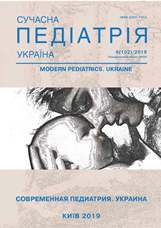Follow-up observation during 10 years of children who were born to seropositive mothers (that are infected with cmv and the hsv-1)
Keywords:
children, Cytomegalovirus (CMV), Herpes simplex virus type I (HSV-1), morbidityAbstract
The relevance of the work is due to the lack of the information devoted to a long-term follow-up observation of the children's health condition, who were born to seropositive mothers (that are infected with CMV and the HSV-1).Purpose. To explore the frequency and structure of diseases of children, born to seropositive mothers that are infected with CMV and the HSV-1 on the basis of the 10-years analysis of clinical and paraclinical features of the disease process.
Materials and methods. There were 41 children under surveillance aged under 10 years, among them were 13 children (the 1st group ) born from Cytomegalovirus-infected mothers and 18 children (the 2d group) born to mothers infected with Herpes simplex in combination with Cytomegalovirus and 10 children born to uninfected mothers (control III group). Follow-up children observation has been conducted for 10 years and included exploring of frequency and structure of diseases based on the analysis of clinical and paraclinical features of the diseases process.
Results. According to the to results of the observation, the probable dependence of the frequency of respiratory reccurent diseases of early aged children (up to 3 years) on the type of infection of mothers was established. Respiratory reccurent diseases were surely more frequently found among children from the 2d group. After 3 years a significant difference in the structure of children's diseases of the 1st and the 2d groups was found, first of all, due to the prevalence of nasopharynx pathology (recurrent tonsillitis, adenoids, sinusitis) of the children from the 1st group. At the same time, such diseases as atopic dermatitis, kidney pathology, conjunctivitis, otitis media, functional disorders of the digestive tract and connective tissue dysplasia were found more frequently in the children from the 2d group.
Conclusions. The results of the observation revealed a clear and reliable dependence of the frequency, structure, the process of diseases and formation of disorders — on the age of children, the type and combination of viruses which infected mothers of the examined children, the burden obstetric anamnesis, gestational complications and complications of childbirth.
The research was carried out in accordance with the principles of the Helsinki Declaration. The study protocol was approved by the Local Ethics Committee (LEC) of all participating institution. The informed consent of the patient was obtained for conducting the studies.
References
Berezhniy VV, Bondarets YI. (2018). Persistence of herpes virus infection in children and its role in juvenile rheumatoid arthritis (a literature review). Sovremennaya pediatriya. 6(94): 59–69. https://doi.org/10.15574/SP.2018.94.59.
Vozianova LI. (2008). TORCH infections. Modern infections. 4: 4–10.
Gerasimchuk TS. (2016). More effective prophylaxis of respiratory infections in children of early age and prognosis of recurrent relapse. Candidate's thesis (Medical Sciences). Zaporizhzhia: Zaporizhzhya State Medical University: 147.
Dzhalmukhamedova EI. (2014). Clinical and prognostic significance of cytomegalovirus infection in the development of frequent diseases in children of pupils of an orphanage. Candidate's thesis (Medical Sciences) Astrakhan: Astrakhan State Medical Academy: 141.
Znamenska TK, Sribna VYe, Saiun KO. (2010). Disorders of intestinal microbiocenosis in infants from mothers with herpes virus infection. Health of woman. 9: 110-112.
Likhachova AS, Zosymov AM, Redko II. (2012). Diahnostychni kryterii vnutrishnoutrobnykh virusnykh infektsii u novonarodzhenykh . Perinatologiya i Pediatriya 4(52): 41–42.
Redko II. (2015) Follow-up in childrens of intrauterine viral infections. Neonatology, surgery and perinatal medicine. 5;1(5): 28–32. https://doi.org/10.24061/2413-4260.V.1.15.2015.5
Tolkach SM, Pysarev AO, Medvedenko HF, Poiarkova OA. (2002). Klinichnyi perebih vahitnosti, polohiv ta stan novonarodzhenoho u zhinok, infikovanykh tsytomehalovirusom. Perinatologiya i Pediatriya 5–6: 65–69.
Usachova EV. (2011). Comparative clinico;immunological characteristic of seronegative and seropositive to herpes viruses children in early age. Sovremennaia pedyatriya. 2(36): 71–74.
Fesenko ME, Melashchenko EI. (2012). The morbidity, physical and neuro-psychic development children with congenital cytomegalovirus infection. Sovremennaia pedyatryia. 3(43): 42–44.
Fesenko ME, Melashchenko OI, Fastovets MN. (2013). Clinical picture, course and catamnesis of children with congenital cytomegalovirus and herpes infections. Ukrainian Medical Almanac. 16;2: 166–167.
Chernyshova OYe. (2016). Differentiated approach to the treatment and secondary prevention of asthma on the background of persistent infections in children. Child's Health. 8(76): 28;34. https://doi.org/10.22141/2224-0551.8.76.2016.90820
Yulish YeI. (2015). Cytomegalovirus infection in children: treatment approaches in different course of infection. Child's Health. 4(64): 11–18.
Baker DA. (2007). Consequences of herpes simplex virus in pregnancy and their prevention. Curr Opin Infect Dis. 20;1: 73–76. https://doi.org/10.1097/QCO.0b013e328013cb19; PMid:17197885
McCarthy F, Jones P, Rowlands C, Giles S. (2009). Primary and secondary cytomegalovirus in pregnancy. The Obstetrician and Gynaecologist. 11: 96–100. https://doi.org/10.1576/toag.11.2.096.27482
Verhagen LM, de Groot R. (2015). Recurrent, protracted and persistent lower respiratory tract infection: а neglected clinical entity. J Infect. 71: 106–111. https://doi.org/10.1016/j.jinf.2015.04.011; PMid:25917807.
Downloads
Issue
Section
License
The policy of the Journal “MODERN PEDIATRICS. UKRAINE” is compatible with the vast majority of funders' of open access and self-archiving policies. The journal provides immediate open access route being convinced that everyone – not only scientists - can benefit from research results, and publishes articles exclusively under open access distribution, with a Creative Commons Attribution-Noncommercial 4.0 international license (СС BY-NC).
Authors transfer the copyright to the Journal “MODERN PEDIATRICS. UKRAINE” when the manuscript is accepted for publication. Authors declare that this manuscript has not been published nor is under simultaneous consideration for publication elsewhere. After publication, the articles become freely available on-line to the public.
Readers have the right to use, distribute, and reproduce articles in any medium, provided the articles and the journal are properly cited.
The use of published materials for commercial purposes is strongly prohibited.

